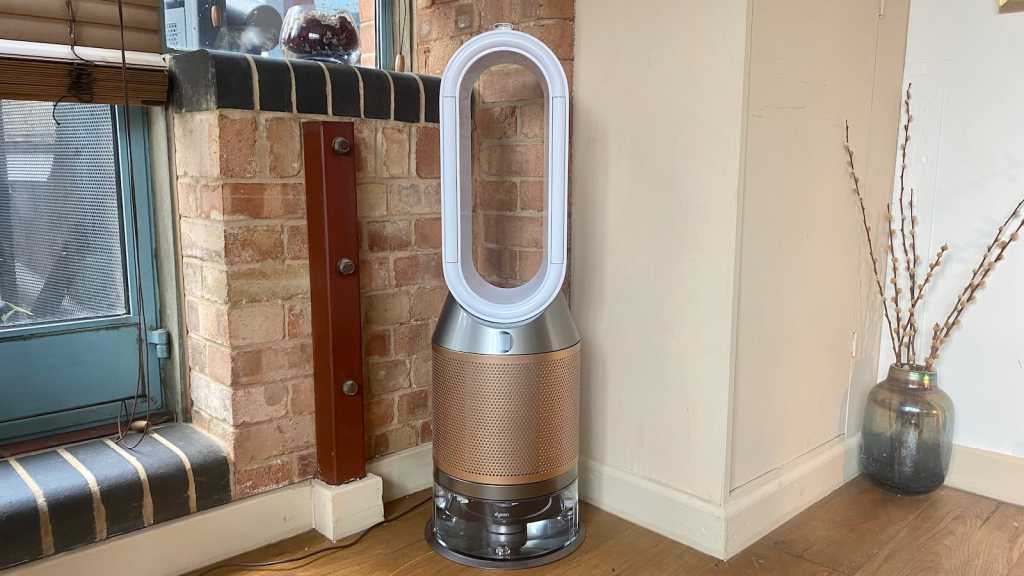Expert’s Rating
Pros
- Quiet fan
- Humidifier easy to use
- Excellent air quality display & app
- Sensitive air purifier
Cons
- Slight whine in operation
- Not very portable
- Expensive
Our Verdict
If you’re looking for a humidifier, this is the luxury option to go for. It will also purify and cool your air and it has high-quality smart features and an in-depth display. Still, it’s not quite perfect: it has a slight whine when running.
Price When Reviewed
$919.99
Best Prices Today: Dyson Purifier Humidify + Cool Formaldehyde
There’s no more recognisable home appliance than a Dyson fan, thanks to its iconic design. The bladeless fan is available in a number of different forms: heating, cooling, air purifying and humidifying – and various combinations of these.
You can browse all the available appliances on the Dyson website in the US or the UK. They start in price at $419.99 in the US for a purifying fan or £349.99 for the simple Cool Tower Fan in the UK, and go up to $939.99/ £699.99 for Dyson’s newest multifunctional appliances.
We’re looking at Dyson’s latest combination air care appliance: the Purifier Humidify + Cool Formaldehyde (PH04). It’s a bladeless air purifying fan and humidifier. As the name suggests, it’s also one of the few air purifiers available that specifically targets and destroys formaldehyde in the air.
Design and build
- Comprehensive, full colour display
- Remote and app control
- Not very portable: no wheels, fairly heavy at 8.2kg/ 18lbs
The Purifier Humidify + Cool Formaldehyde comes in a white, nickel and (very coppery) gold colourway. If you’re in the US, you can get it in nickel and (coppery) gold for $20 more. The key difference between the two colourways is that the fan loop is in silver rather than white.
If you’ve never seen a Dyson fan in real life, you might not know that they vary in size. This one is 92.3cm high, with a 31cm diameter base. Its footprint is probably slightly smaller than that of a standing fan and it’s not quite as tall. It would be a perfect height to cool you if you were sitting on a sofa.
Still, it’s not quite as compact as the Purifier HP09 Hot+Cool Formaldehyde. Although the two appliances share a very similar design, the clear water tank at the base of the humidifying model adds some height and marks out its specific function.
It’s a fairly heavy appliance at 8.2kg/ 18lbs and it doesn’t have wheels, so you’ll probably want to find a spot for it and leave it there. It’s not really suitable for moving from room to room with you.
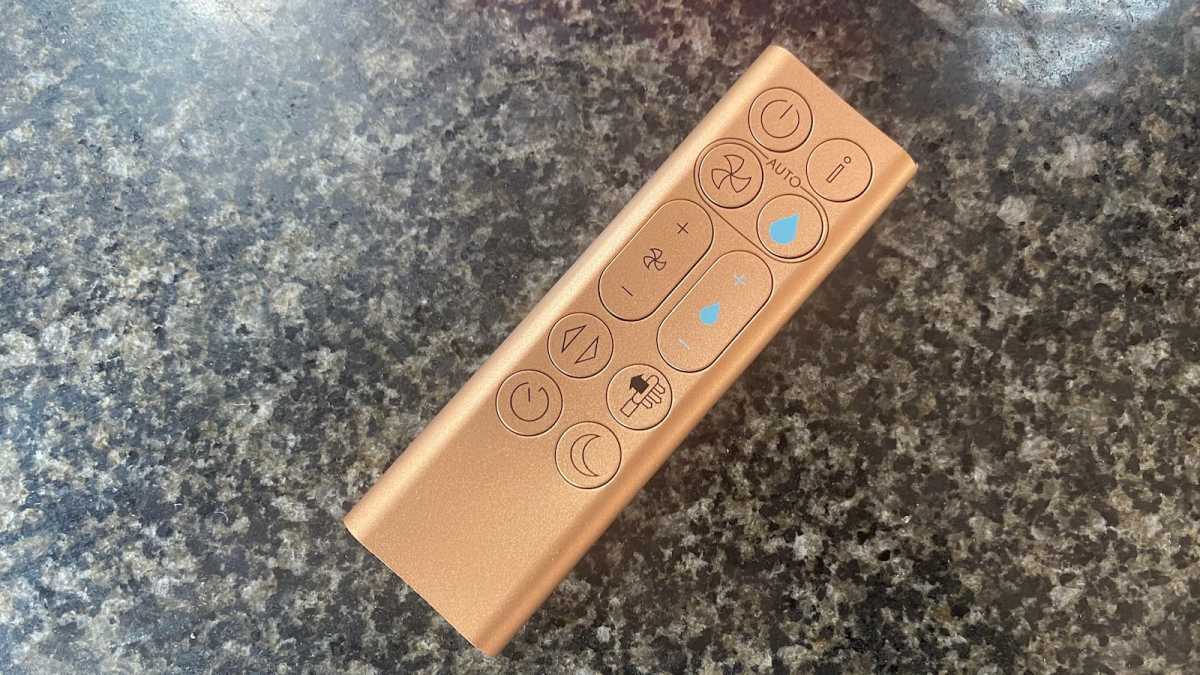
Emma Rowley / Foundry
It comes with a matching copper-coloured remote control that, in a nice touch, magnetically attaches to the top of the appliance so you won’t lose it.
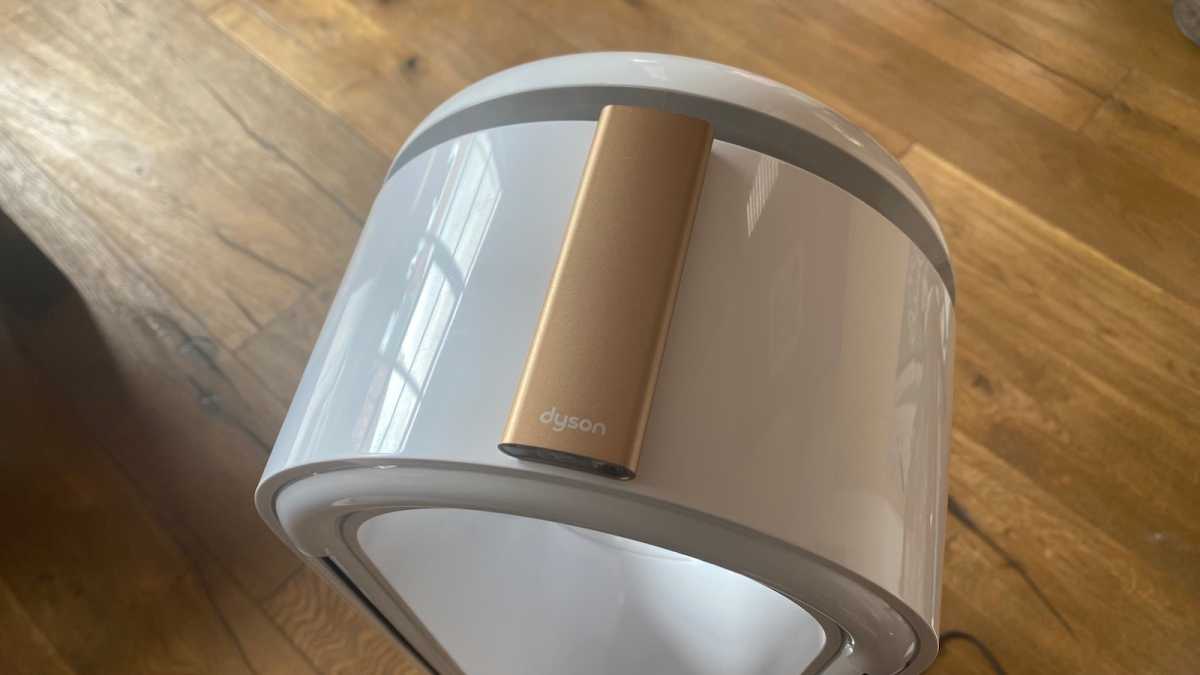
Emma Rowley / Foundry
On the appliance’s front is a round, full colour display. You can use the ‘i’ button on the remote to cycle through and show all potential measurements. It’s an extremely comprehensive list that shows:
- Air quality
- PM 2.5 (smaller particles)
- PM10 (larger but still inhalable particles)
- HCHO (formaldehyde)
- VOCs (volatile organic compounds – toxic and smelly gases)
- NO2 (nitrous dioxide – typically from vehicle emissions)
- Temperature
- Humidity level
All of the air quality indicators have a four-colour chart – from green (good) to red (very poor) – so you can get at-a-glance information.
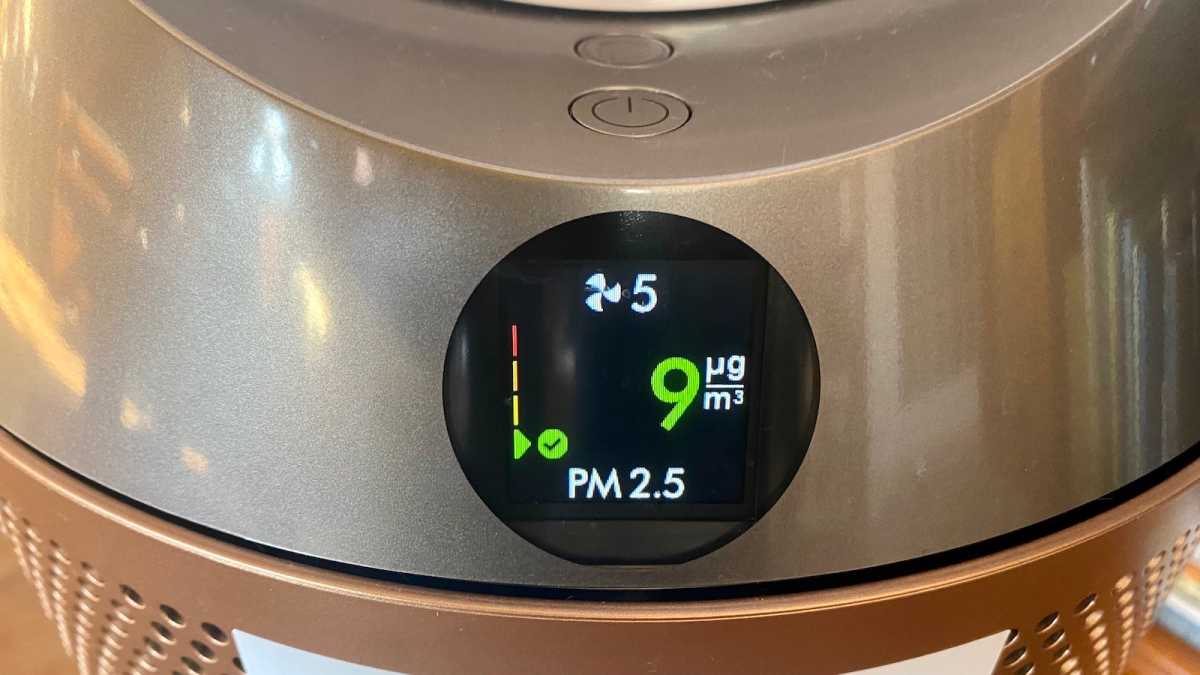
Emma Rowley / Foundry
You can also use the onscreen display to check the remaining filter life and your Wi-Fi signal.
MyDyson app
The Purifier Humidify + Cool Formaldehyde is a connected device that you can also control via the MyDyson app. This is a big plus as the app (formerly called Dyson Link) is beautifully designed and easy to use.
In our test, the appliance connected quickly and without trouble. Still, your results may vary, depending on the strength of your Wi-Fi signal.
Once linked, you can control your machine, view your air quality and see air quality trends, all in app. It’s also a straightforward business to connect to your Alexa, Siri or Google Home voice assistant, so you can switch it on and off with voice commands and add it to routines.
The app also contains a wealth of information on how to use your machine and troubleshooting.
Setting up the Purifier Humidify + Cool Formaldehyde
The machine’s set-up is not complicated. First, the tape needs to be removed and the filters fitted.
However, it might be an idea to watch the Dyson set-up video. If you do, you’ll see a model interacting with the machine with all the considered elegance of a Japanese tea ceremony. That is certainly not how it looked when I did it.
There’s a slight trick to removing the filters and the water tank: you need to use both hands at once to press the buttons on each side. This may mean that it may not be an ideal product for a disabled user.
While I found the water tank easy to move once I learned this, I still found the filter covers a bit fussy. They don’t attach and detach in a satisfying manner.
Next, you’ll remove the tank at the base and fill it with water. The tank is well designed, with wheels underneath and a carry handle on top, so it’s easy to do. And that’s it – very straightforward.
Using the fan
- 10 speed settings
- Oscillation
- Timer
The fan has 10 speed settings and is quiet in operation. Even at the highest setting, all you can hear is the sound of rushing air. There’s no mechanical noise at all.
However, I did find that that the appliance whines in operation. It’s audible when the fan is on its lower settings.
The top setting is very powerful as a personal cooling fan, in part thanks to Dyson’s air multiplier technology. What this means is that more air is drawn in from behind the fan and from the sides when it’s in operation.
Presumably, however, this air won’t have just gone through the purifier, which means that it may not be the best choice for people with hay fever or similar issues, who are looking for an air purifier/fan to help with their allergies.
However, if you don’t want the cooling feature, you can change the direction of the airflow so that it comes out at the back of the machine and doesn’t blow directly at you, so this may help.
You can turn on fan oscillation to cool a wider area. There’s also a timer which you can set to 30 minutes, or 1, 2, 4 or 8 hours, and a night mode that sets it going on its quietest level and dims the display.
The fan also has breeze mode, which varies the airflow “to mimic a cooling refreshing breeze”. I’ve yet to meet anyone who finds this mode anything other than annoying but someone out there must like it: whoever it is, take note.
Using the air purifier
- Catalytic (anti-formaldehyde) filter never needs replacing
- Replace HEPA filter annually at a cost of $79.99/ £65
- Air quality monitor is sensitive
Th unusual element in this purifier is the catalytic filter, which breaks down formaldehyde in the air and which will never need replacing.
You might have formaldehyde in your air if you’re painting or decorating, use fuel-burning appliances or just from cleaning products and cosmetics.
This is why its excellent display is so valuable: if your air purifier doesn’t give you much information, you won’t always realise when you need to use it
Outside of this, the purifier has a three-stage, HEPA filter that cleans the air of VOCs, smaller (PM2.5) and larger (PM10) particles. This is a comprehensive filter system that should remove anything unpleasant from your air at home.
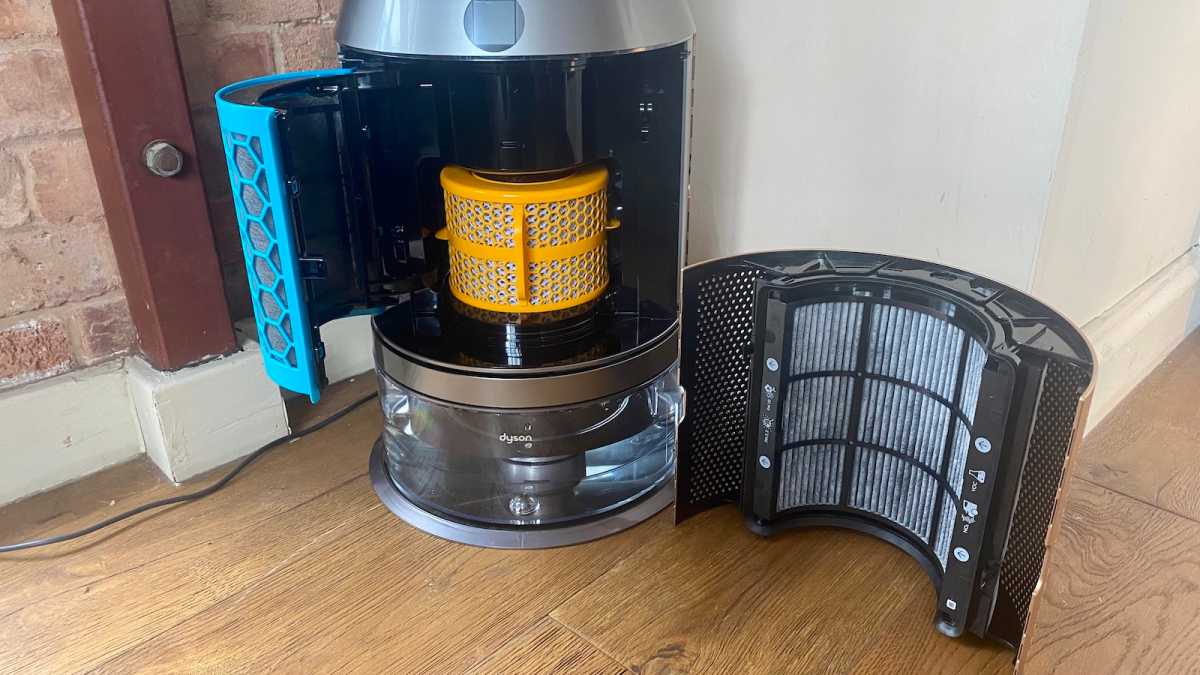
Emma Rowley / Foundry
Still, it’s hard to measure its effectiveness against air purifiers from other brands. If you take a look at our round-up of the best air purifiers we’ve tested, you’ll see that most appliances show a clean air delivery rate (CADR), which is an industry-wide system of measurement, showing how long it takes to clean a room of a given size of different types of pollutants.
However, Dyson has some objections to CADR as a measurement and doesn’t really use it. You can find out more on the Dyson website. So, all we can do is tell you how it well it worked during our testing period.
I might have been a tiny bit sceptical before using it – because of Dyson’s stance on CADR – but I was impressed in the test.
The appliance was set up in the living room, and after we had cooked lunch on the hob in the kitchen on the other side of the hall, the display showed a rise in PM 2.5 pollution in the air and assessed the air quality as poor.
My home is by no means of palatial size but this is the first time an air purifier has been sensitive enough to detect that change so far away from the kitchen. It could also detect a change in air quality from a window opening, and from a spray cleaner used in another room.
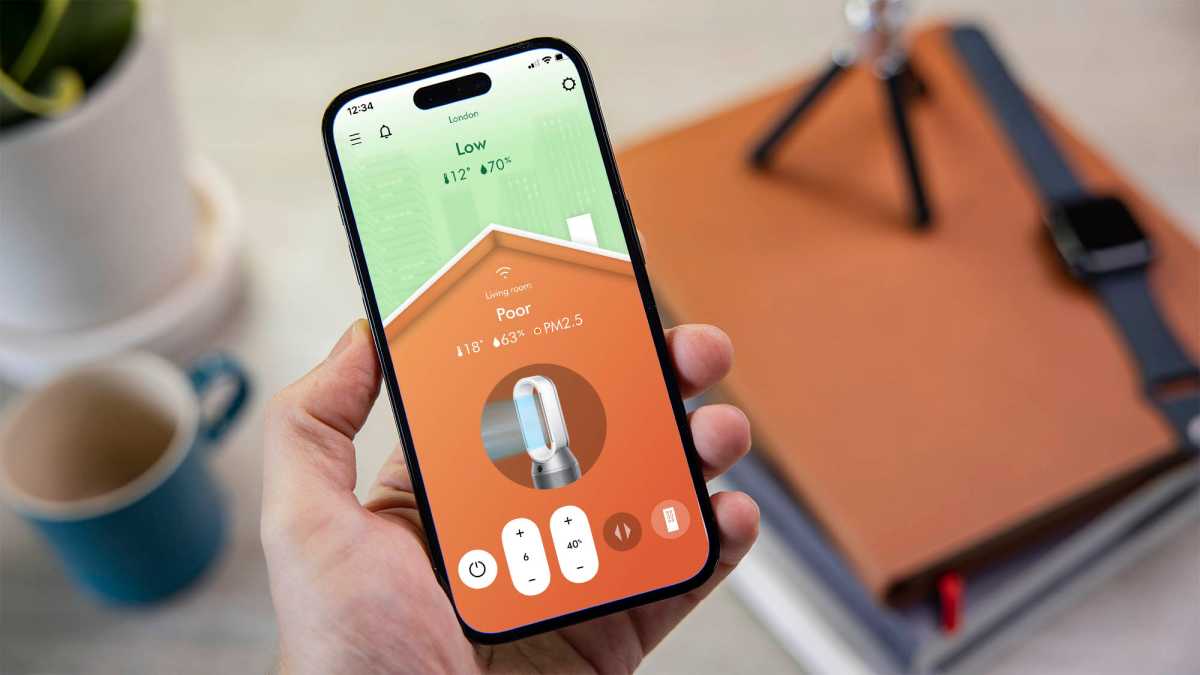
Emma Rowley / Foundry
We’ve tended to have the windows closed most of the time recently, because of the unseasonably cold weather, which doesn’t help indoor air quality. Seeing the change in air quality on the display motivated me to run the air purifier and open the windows regularly to refresh the air.
This is why its excellent display is so valuable: if your air purifier doesn’t give you much information, you won’t always realise when you need to use it.
The only issue to flag with the purifier is the ongoing cost. The 360° Glass HEPA+Carbon filter costs $79.99/ £65 to replace, which is a little pricier than those of rivals. The machine will let you know when it’s time to change it, but Dyson recommends you do so every year.
Still, whichever air purifier you buy, you’ll need to replace the filter. People question why they’re not washable, but if they have a VOC-catching carbon layer, that’ll just get saturated over time and there’s no option but to replace it.
Using the humidifier
- Easy to use
- Auto mode
- Can be switched off if you only want the fan and purifier
The humidifier element will probably mean that this Dyson appliance is more niche than other combination fan models. Depending on where you are in the world, you might have more problems with damp than with a lack of it.
If you don’t want to use the humidifier all the time, you can switch this function off and just use the appliance as a fan and air purifier.
The humidifier couldn’t be easier to use. You just need to fill the water tank and press a single button
However, if you have your windows closed a lot and the heating on (and congratulations if you can afford that) you might find that you get sinus headaches, dry skin and cracked lips, or that there’s a lot of static, all of which can be signs that the air in your home is too dry.
Estimates of the ideal humidity level vary a bit, but it’s a range from 30-60% or from 40-70%, depending on which source you use. Within that range, you’ll find a comfortable level.
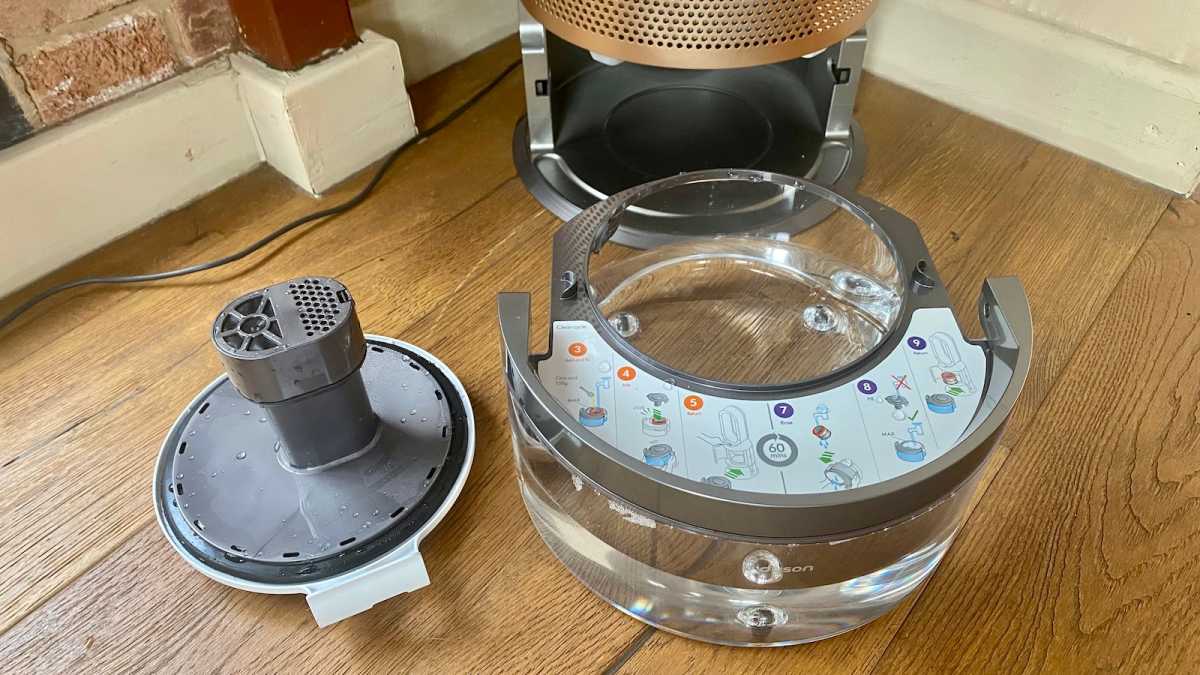
Emma Rowley / Foundry
The humidifier couldn’t be easier to use. You just need to fill the water tank and press a single button.
You can choose auto humidify or set a level from 30%-70%. Obviously, though, this is a humidifier, not a dehumidifier, so you can’t lower your room’s humidity with this appliance. We have tested the excellent Meaco Arete One if you’re looking for a dehumidifier.
Earlier models of the Dyson humidifier were reported to have problems with the deep cleaning cycle. So it was a bit of a worry when, after only using the appliance once, it wouldn’t turn on and requested a deep clean right away. However, there’s a video that shows how to do it (you’ll need citric acid and it takes an hour) and after a deep cleaning cycle, it ran perfectly.
One thing to note is that the air where I live tends towards dampness, especially at this time of year. That means we had no problems reaching a healthy humidity threshold and were unable to test how it performed in an area with very dry air.
Price and availability
At the time of writing, we could only find the Purifier Humidify + Cool Formaldehyde for sale from Dyson (US, £919.99 or 939.99, depending on the colourway; UK, £699.99).
It’s at the top end of the price range for Dyson’s air care appliances. That’s because of its multi-functionality and the fact that it can destroy formaldehyde in the air, which is a rare feature. It does everything that any Dyson fan can – except for heating.
Verdict
You can buy all of the appliances that make up the Purifier Humidify + Cool Formaldehyde separately, for less than the price of this one. But then you’d be storing and using at least three separate appliances – four, if you want a really good air quality monitor – and we doubt that any would be as comprehensive and…
